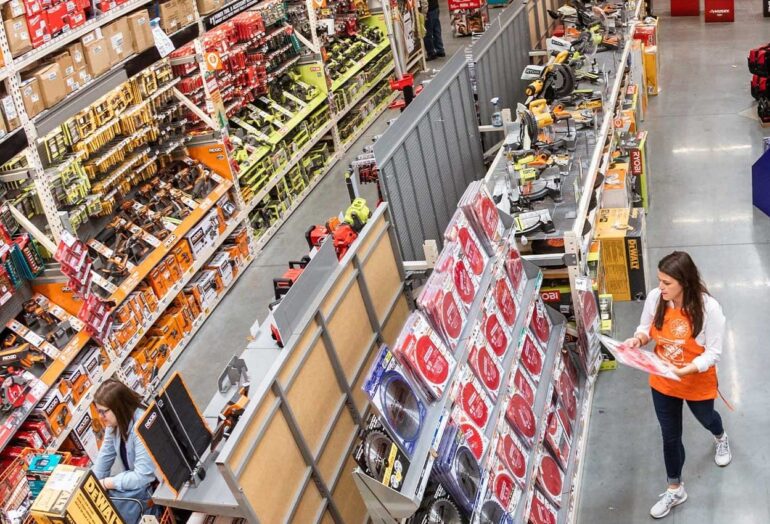TL;DR:
- The Home Depot is using ML and computer vision technology to optimize product management across its extensive retail network.
- Their ML-powered app, Sidekick, is designed to enhance staff productivity and streamline product retrieval.
- Sidekick utilizes cloud-enabled ML algorithms and data from various sources, including transactional systems and video camera feeds.
- Computer vision technology is employed to capture images of store locations, providing insights into product availability.
- The company’s iterative approach to technology implementation has yielded positive results, with a focus on seamless integration.
- The Home Depot aims to refine the Sidekick app further and explore new data-driven opportunities.
Main AI News:
In the competitive world of home improvement retail, managing inventory efficiently across numerous stores and warehouses can be a daunting task, especially during the bustling holiday season and the Black Friday rush. However, The Home Depot is tackling this challenge head-on by harnessing the power of cutting-edge technology, combining machine learning (ML) and computer vision, to streamline product retrieval for its customers.
Hari Ramamurthy, a technology fellow at The Home Depot, emphasizes the company’s strong focus on technology-driven solutions. “We are very much a technology-focused company,” he affirms. “We look for ways we can leverage the latest and best technologies to materially improve the experience for our staff and ultimately our customers.“
One of the notable innovations from The Home Depot is the ML-powered app called “Sidekick,” which is designed to enhance staff productivity. This app, integrated with computer vision capabilities, operates on mobile devices known as “hdPhones,” which have been developed in collaboration with industry leaders like Zebra Technologies, HPE, and Aruba. Sidekick was launched at the beginning of 2023 and represents the latest advancement in the company’s data-centric initiatives.
Ramamurthy explains that Sidekick employs a cloud-enabled ML algorithm, custom-built by The Home Depot, to help staff prioritize their tasks effectively. By ensuring that associates focus on high-demand products and aiding them in locating items in hard-to-reach areas, such as overhead shelves, the app enhances overall efficiency. “We’re using multiple signals generated from internal data sources to inform our algorithm,” he points out.
Notably, the ML model goes beyond conventional retail data sources by tapping into semi-structured data, such as video camera feeds that track customer movements within the stores. Associates also play a crucial role in the process, capturing images of various store locations using the Sidekick app on their hdPhones. These images provide valuable insights into product availability on the shelves. “Computer vision is a good example of data that’s coming from a non-transactional system and informing our algorithms,” Ramamurthy adds.
While Sidekick is a data-intensive tool that relies on staff input, Ramamurthy emphasizes the importance of making the technology seamless for associates. “Our goal is to make the technologies fade into the background and to be as seamless as possible,” he says. The aim is to prioritize tasks without burdening the staff with understanding the complex factors behind task generation.
In his role as a technology fellow, Ramamurthy is dedicated to continually refining the Sidekick app and exploring new avenues for data-driven innovation. “We’re constantly looking for ways to optimize how we perform certain tasks,” he notes, highlighting the company’s commitment to addressing customers’ challenges through next-generation experiences.
The Home Depot’s journey into the realm of ML and artificial intelligence (AI) has not been without challenges. However, Ramamurthy underscores the importance of an iterative approach. “Our experience has been very iterative,” he explains. The company’s “crawl, walk, run approach” to delivering value has allowed it to make incremental improvements and overcome challenges along the way. As a result, The Home Depot is pleased with the performance and overall experience for its associates.
Looking ahead, Ramamurthy and his team continue to seek small, yet impactful, enhancements to the Sidekick app. They also plan to expand their focus beyond task generation, delving into aspects like analyzing sales data and optimizing store layouts. “Those are all areas for further exploration,” Ramamurthy concludes, emphasizing the company’s dedication to innovation and improvement.
Conclusion:
The Home Depot’s adoption of advanced technologies like machine learning and computer vision exemplifies its commitment to enhancing efficiency and customer experience. This approach sets a precedent for the retail market, emphasizing the importance of leveraging emerging technologies for productivity gains and improved service delivery. Competitors in the sector should consider similar iterative strategies to stay competitive and meet evolving customer expectations.

